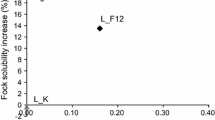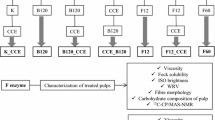Abstract
Industrially produced bleached recycled pulp (R) comprising essentially hardwood fibres was subjected to enzymatic treatment with endo-xylanase from Thermomyces lanuginosus with or without ultra-high hydrostatic pressure (UHP) pre-treatment at 300–600 MPa for 10 min. The kinetics and the extent of enzymatic hydrolysis after UHP pre-treatment under different conditions have been evaluated by released reducing sugars and the analysis of neutral sugars in pulps, respectively. The changes in surface chemical composition of pulps were assessed by UV-vis diffuse reflectance spectroscopy. UHP-pre-treated R under optimal conditions (400 MPa), with or without posterior enzymatic treatment, was used for the production of handsheets and evaluation of its mechanical properties. It was suggested that enzymatic modification improves significantly the papermaking properties of recycled pulp. These improvements were related with selective removal of xylan bound to impurities and to aggregated cellulose fibrils on the fibre surface, thus favouring the ensuing swelling and inter-fibre bonding in paper. UHP pre-treatment and posterior enzymatic treatment revealed a synergetic effect on the mechanical properties of recycled pulp. This fact was assigned to enhanced accessibility of fibres towards xylanase and by forced hydration and favourable rearrangement of cellulosic fibrils in fibres after UHP pre-treatment. The increase of basic strength properties after UHP-promoted xylanase treatment was up to 30 % being the most pronounced for the tensile strength and the burst resistance.






Similar content being viewed by others
References
Bajpai PK (2010) Solving the problems of recycled fiber processing with enzymes. Bioresources 5:1311–1325. doi:10.1016/S0045-6535(99)00068-5
Bajpai P (2012) Chapter 12. Production of dissolving-grade pulp. In: Biotechnology for pulp and paper processing. Springer, New York, pp. 193–209
Bajpai P (2014) Chapter 1. Introduction. In: Recycling and deinking of recovered paper. Elsevier, London, pp. 1–18
Bajpai P (2015) Chapter 4. Enzymes. In: Pulp and paper industry. Chemicals. Elsevier, Amsterdam, pp. 275–314
Bhat MK (2000) Cellulases and related enzymes in biotechnology. Biotechnol Adv 18:355–383. doi:10.1016/S0734-9750(00)00041-0
Blanco A, Negro C, Monte C, Fuente E, Tijero J (2004) The challenges of sustainable papermaking. Environ Sci Technol 38:414A–420A. doi:10.1021/es040654y
Clark J d Á (1985) Pulp technology and treatment for paper, 2nd edn. Miller Freeman Publ. Inc., San Francisco, pp. 277–305
Fernandes Diniz JMB, Gil MH, JAAM C (2004) Hornification—its origin and interpretation in wood pulps. Wood Sci Technol 37:489–494. doi:10.1007/s00226-003-0216-2
Ferreira ARFC, Figueiredo AB, Evtuguin DV, Saraiva JA (2011) High pressure pre-treatments promote higher rate and degree of enzymatic hydrolysis of cellulose. Green Chem 13:2764–2767. doi:10.1039/C1GC15500H
Figueiredo A, Evtuguin DV, Saraiva J (2010) Effect of high pressure treatment on structure and properties of cellulose in eucalypt pulps. Cellulose 17:1193–1202. doi:10.1007/s10570-010-9454-2
Gehmayr V, Sixta H (2011) Dissolving pulps from enzyme treated kraft pulps for viscose application. Lenzinger Berichte 89:152–160
Gil N, Gil C, Amaral ME, Costa AP, Duarte AP (2009) Use of enzymes to improve the refining of a bleached Eucalyptus globulus kraft pulp. Biochem Eng J 46:89–95. doi:10.1016/j.bej.2009.04.011
Hubbe MA, Venditti RA, Rojas OJ (2007) What happens to cellulosic fibers during papermaking and recycling? A review. Bioresources 2:739–788. doi:10.15376/biores.2.4.739-788
ISO 534:2011 (2011) Paper and board—determination of thickness, density and specific volume. In ISO, Geneva, Switzerland
ISO 1762:2015 (2015) Paper, board and pulps—determination of residue (ash) on ignition at 525 degrees C. In ISO, Geneva, Switzerland
ISO 1924-2:2008 (2008) Paper and board—determination of tensile properties. Part 2: constant rate of elongation method (20 mm/min). In ISO, Geneva, Switzerland
ISO 1974:2012 (2012) Paper—determination of tearing resistance—Elmendorf method. In ISO, Geneva, Switzerland
ISO 2470-1:2009 (2009) Paper, board and pulps—measurement of diffuse blue reflectance factor. Part 1: indoor daylight conditions (ISO brightness). In ISO, Geneva, Switzeerland
ISO 2758:2014 (2014) Paper—determination of bursting strength. In ISO, Geneva, Switzerland
ISO 5267-1:1999 (1999) Pulps—determination of drainability. Part 1: Schopper-Riegler method. In ISO, Geneva, Switzerland
ISO 5269-2:2004 (2004) Pulps—preparation of laboratory sheets for physical testing. Part 2: Rapid-Köthen method. In ISO, Geneva, Switzerland
ISO 5636-5:2013 (2013) Paper and board—determination of air permeance (medium range). Part 5: Gurley method. In ISO, Geneva, Switzerland
Jayme G (1958) Properties of wood celluloses. II. Determination and significance of water retention value. TAPPI J 41:180A–183A
Jiang Q, Yang G, Wang Q, Sun Q, Lucia LA, Chen J (2016) Ultrasound-assisted xylanase treatment of chemi-mechanical poplar pulp. Bioresources 11:4104–4112
Lee JY, Lee HL, Lim HW, Youn HJ (2008) Removal of fluorescent whitening agents from recycled fibers using enzyme. Nord Pulp Pap Res J 23:19–23. doi:10.3183/NPPRJ-2008-23-01-p019-023
Lee CK, Ibrahim D, Che Omar I (2013) Enzymatic deinking of various types of waste paper: efficiency and characteristics. Process Biochem 48:299–305. doi:10.1016/j.procbio.2012.12.015
López Lorenzo M, Nierstrasz VA, Warmoeskerken MMCG (2009) Endoxylanase action towards the improvement of recycled fibre properties. Cellulose 16:103–115. doi:10.1007/s10570-008-9246-0
Miller GL (1959) Use of dinitrosalicylic acid reagent for determination of reducing sugar. Anal Chem 31:426–428. doi:10.1021/ac60147a030
Minor JL (1994) Hornification—its origin and meaning. Prog Pap Recycl 3:93–95
Nair S, Sindhu R, Shashidhar S (2010) Enzymatic bleaching of kraft pulp by xylanase from Aspergillus sydowii SBS 45. Indian J Microbiol 50:332–338. doi:10.1007/s12088-010-0049-2
Oliveira SCT, Figueiredo AB, Evtuguin DV, Saraiva JA (2012) High pressure treatment as a tool for engineering of enzymatic reactions in cellulosic fibres. Bioresour Technol 107:530–534. doi:10.1016/j.biortech.2011.12.093
Ona T (ed) (2004) Improvement of forest resources for recyclable forest products. Springer Japan, Tokyo, pp. 3–66
Pathak P, Bhardwaj NK, Singh AK (2011) Optimization of chemical and enzymatic deinking of photocopier waste paper. Bioresources 6:447–463
Prozil SO, Evtuguin DV, Cruz Lopes LP (2012) Structural characterization of polysaccharides isolated from grape stalks of Vitis vinifera L. Carbohydrate Res 356:252–259. doi:10.1016/j.carres.2012.02.001
Rebuzzi F, Evtuguin DV (2006) Effect of glucuronoxylan on the hornification of Eucalyptus globulus bleached pulps. Macromol Symp 232:121–128. doi:10.1002/masy.200551414
SCAN-CM 15:88 (1988) Viscosity in cupri-ethylenediamine solutions. In: Scadinavian pulp, paper and board testing committee. Stockholm, Sweden.
Selvendran RR, March JF, Ring SG (1979) Determination of aldoses and uronic acid content of vegetable fiber. Anal Biochem 96:282–292. doi:10.1016/0003-2697(79)90583-9
Singh A, Yadav RD, Kaur A, Mahajan R (2012) An ecofriendly cost effective enzymatic methodology for deinking of school waste paper. Bioresour Technol 120:322–327. doi:10.1016/j.biortech.2012.06.050
Sousa JIT, Moura AIG, Evtuguin DV, Carvalho MGVS (2016) Enzymatic treatment applied as a final stage in E. globulus kraft pulp bleaching. J Chem Technol Biotechnol 91:547–554. doi:10.1002/jctb.4624
TAPPI T204 om-88 (1996) Solvent extractives of wood and pulp. In TAPPI, Atlanta
Torres JMO, dela Cruz TEE (2013) Production of xylanases by mangrove fungi from the Philippines and their application in enzymatic pretreatment of recycled paper pulps. World J Microbiol Biotechnol 29:645–655. doi:10.1007/s11274-012-1220-1
Tze WT, Gardner DJ (2001) Swelling of recycled wood pulp fibers: effect on hydroxyl availability and surface chemistry. Wood Fiber Sci 33:364–376
Viesturs U, Leite M, Eisimonte M, Eremeeva T, Treimanis A (1999) Biological deinking technology for the recycling of office waste papers. Bioresour Technol 67:255–265. doi:10.1016/S0960-8524(98)00119-9
Virtanen Y, Nilsson S (1993) Environmental impacts of waste paper recycling. Earthscan Publ. Ltd, New York, pp. 1–38
Acknowledgments
The authors acknowledge the Fundação para a Ciência e Tecnologia (FCT) and Renova FPA S.A. for PhD grant SFRH/BDE/51855/2012. This work was developed within the scope of the project CICECO-Aveiro Institute of Materials, POCI-01-0145-FEDER-007679 (FCT Ref. UID/CTM/50011/2013), and financed by ERDF Funds through the Operational Competitiveness Programme COMPETE, in the frame of project FCOMP-01-0124-FEDER-30203. The authors would also like to acknowledge FCT/MEC for the financial support to QOPNA Research Unit (FCT UID/QUI/00062/2013), through national funds and where applicable co-financed by the FEDER, within the PT2020 Partnership Agreement. Finally, the authors thank Renova FPA S.A. for supplying the materials and technical facilities.
Author information
Authors and Affiliations
Corresponding author
Ethics declarations
Conflict of interest
The authors declare that they have no competing interests.
Ethical statement
This article does not contain any studies with human participants or animals performed by any of the authors.
Rights and permissions
About this article
Cite this article
Salgueiro, A.M., Evtuguin, D.V., Saraiva, J.A. et al. High pressure-promoted xylanase treatment to enhance papermaking properties of recycled pulp. Appl Microbiol Biotechnol 100, 9885–9893 (2016). https://doi.org/10.1007/s00253-016-7703-5
Received:
Revised:
Accepted:
Published:
Issue Date:
DOI: https://doi.org/10.1007/s00253-016-7703-5




